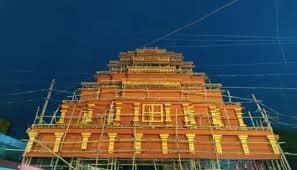
Idol-Making in Patna During Sharadiya Navratra
Every year, more than 5,000 idols are crafted in Patna for Durga Puja celebrations. Nearly 65–70% of these are made in the traditional Pal style of Bengal, attracting artisans from across the region.
Bengal Artisans Bring Pal Style to Patna
Around 1,000 artisans travel from Bengal months before Navratra.
Work begins 3–4 months in advance.
Idols are crafted with bamboo, straw, clay, and natural colors.
Fusion of Pal and Modern Artistry
While many idols are made in the classic Pal style, some combine Pal and modern techniques, offering a fresh look to traditional Durga idols. These blended forms are gaining popularity across Bihar and Jharkhand.
Idol Prices and Demand
Prices range from ₹15,000 to ₹2.5 lakh, depending on size and detail.
Most popular idols are 8–10 feet tall.
Around 75% of idols are made in Patna, with the rest brought from Bengal.
Where the Idols Are Installed in Patna
Durga Puja pandals across Patna showcase these idols, especially in areas like:
Kadamkuan
Badi Patan Devi
Kankarbagh
Rajendra Nagar
Shastri Nagar
Generational Tradition of Idol Makers
Patna is home to several families engaged in idol-making for generations, including the Pal, Sharma, Vishwakarma, and Paswan families. Their work is not only in demand in Patna but also in nearby districts like Nalanda, Vaishali, Samastipur, Jehanabad, and Sheikhpura.
Durga Puja 2025: A Blend of Tradition and Innovation
As the festival approaches, Patna continues to be a hub of idol-making, blending Bengal’s Pal artistry with modern creativity, keeping the spirit of Sharadiya Navratra alive.
Pal Kala (Pal Style of Idol-Making)
Origin:
The Pal Kala (Pal style) of idol-making originates from Bengal, and it is named after the Pal dynasty (8th–12th century) which ruled Bengal and Bihar. The dynasty were great patrons of art, sculpture, and painting, especially of religious figures.Features of Pal Style:
Detailed Craftsmanship – Idols are intricately carved with sharp features and fine detailing.
Traditional Form – Goddesses like Durga, Lakshmi, and Saraswati are given a divine yet graceful look.
Use of Natural Materials – Bamboo framework, straw, clay layers, and natural paints are commonly used.
Expressions & Ornamentation – Special attention is given to facial expressions, eyes (called Chokku Daan), jewelry, and attire.
Narrative Style – Durga idols are often shown with her family (Ganesh, Kartikeya, Lakshmi, Saraswati) and Mahishasura in one frame, telling the entire mythological story.
Modern Adaptation:
In recent times, artisans mix Pal Kala with modern art styles, experimenting with themes, 3D backgrounds, and innovative pandal decorations while keeping the Pal essence alive.
👉 In short, Pal Kala style is a traditional Bengal art form of idol-making that emphasizes beauty, precision, and cultural storytelling, which is why it dominates Durga Puja idol-making in Patna and across India.
How pal kala style reached to Bihar?
1. Origin in the Pal Dynasty (8th–12th century)
The Pal dynasty ruled over large parts of Bengal and Bihar (present-day West Bengal, Bangladesh, and Bihar).
They were great patrons of art, sculpture, and Buddhism, commissioning temples, paintings, and idols.
This period gave birth to the Pal style of art – especially known for its detailed stone and bronze sculptures, manuscript paintings, and clay works.
2. Spread Through Religion and Festivals
The Pal style became deeply rooted in Durga worship traditions in Bengal.
With time, these practices spread to neighboring Bihar, especially in areas like Patna, Nalanda, and Gaya, which were already cultural centers.
Festivals like Durga Puja and Navratra naturally carried the Pal artistic influence into Bihar.
3. Migration of Artisans
Over centuries, idol-making families (Pal, Vishwakarma, Sharma, Paswan) traveled between Bengal and Bihar.
Many Bengali artisans settled in Patna and nearby towns, continuing their craft.
Even today, before Navratra, hundreds of artisans from Bengal migrate to Bihar to make idols, keeping the Pal tradition alive.
4. Demand for Bengal’s Craftsmanship
People in Bihar began preferring idols in the Pal Kala style because of their fine detailing, divine expressions, and storytelling quality.
Around 65–70% of idols in Patna today are made in Pal Kala style, showing how the tradition has been fully embraced.
✅ In short:
The Pal Kala style reached Bihar through the Pal dynasty’s rule, cultural exchanges, and migration of artisans from Bengal. Over centuries, it became an integral part of Bihar’s Durga Puja celebrations, especially in Patna.




